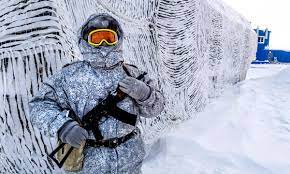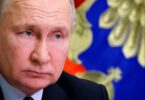Barry Gardiner
Ask Britain’s foreign secretary which part of the world poses his biggest foreign policy challenge, and the chances are he will say either Russia or China. He probably will not say the Arctic. Yet the implications of what is happening in the Arctic will change patterns of international trade, drive food insecurity, deepen global poverty, increase refugee crises, reorient military alliances, and turbocharge military expenditures and the risk of war.
The eight Arctic states – Canada, Finland, Denmark, Iceland, Norway, Sweden, the US and Russia – have long collaborated on scientific research through the Arctic Council, a non-military body. Until now. After Russia’s invasion of Ukraine, Arctic Council meetings ceased. So did cooperation with Russia. This has hampered progress on climate and environmental research and turbocharged the militarisation of the Arctic. The success of the Arctic Council depended on its geopolitical balance. It is not a security alliance and has always tried to remain independent from politics. Five of the eight countries were part of Nato; the other three were not. That has now changed. Finland joined Nato in April. Sweden is in the process of joining. Soon, Nato will literally be surrounding Russia in the Arctic.
To understand why this matters, we must first understand the climate emergency taking place in the region. Summer sea ice has declined by 30% in the past 30 years; 90% of old ice, which is classified as five years old or more, has gone. That ice used to act as the great heat shield for the planet, reflecting back the sun’s rays. But the loss of ice is producing a vicious spiral of heating. The Arctic is now warming three times faster than the global average. This process is called Arctic amplification. It means that scientists now project an Arctic free from summer ice by 2040-45. As the ice cover is lost, a trans-polar route is opening to connect east Asia to Europe and the eastern coast of North America. And the ice barrier that once protected Russia’s northern shore will be exposed as never before. Russia represents 53% of the Arctic coastline and the need to protect its northern border as the ice barrier melts is a key national security concern.
Vladimir Putin already had ambitious plans for the northern sea route, seeking to more than double the cargo traffic. But over the past six years, Russia has also built 475 military sites along its northern border. The port of Severomorsk, on the Kola peninsula, is the base of the country’s northern fleet.
In recent years, the Russians have reactivated 50 Soviet outposts in the Arctic and equipped its northern fleet with nuclear and conventional missiles. The challenge of all this has not been purely logistical. As the permafrost thaws, the structural base for roads, buildings and other key infrastructure has collapsed. Russia is trying to deploy huge amounts of infrastructure and military capacity to build structures on land that is disintegrating, across roads that are disappearing. In December 2022, it passed a new law requiring 90-day notification for any warship transiting the northern sea route. It has also legislated that there be no more than one warship allowed in these waters at any one time and that any submarine be required to surface and show its flag along the internal waters of the route. Recent experience in the Pacific suggests that the US or Nato will seek to assert rights of navigation under the UN convention on the law of the sea. This is inherently risky. Russia could see such attempts to declare freedom of navigation as a provocation. But failure to enforce these freedoms carries an opposite risk: without maintaining a presence in the region, Nato members would be allowing Russia’s new law to become normalised. A careful balancing act is essential to maintain presence and not allow Russia to close off this region of the Arctic as its private domain.
Moscow sees Nato borders expanding. It fears encirclement. Its experience of humiliation in Ukraine has increased this tension. Two Arctic brigades have been deployed to Ukraine with disastrous consequences; the Norwegian Institute for Defence Studies estimates that more than 1,000 personnel have been lost. As Russia’s conventional land forces have been depleted in the Arctic, the Kremlin will turn to its naval and submarine capacity. The potential to inflict damage to undersea cables and pipelines is a lever that Putin could use against his opponents. At the moment, it seems our politicians are not looking beyond the Ukraine war. They need to. A weakened and resentful Russia does not make for a stable global order. We have already seen Putin pivot to China and use the Arctic as a bargaining chip to strengthen that relationship. It is scarcely a month since the two countries’ coastguards signed a memorandum in Murmansk about cooperation in the Arctic. China’s price for providing Russia with support over Ukraine could be requesting naval access to Russian bases in the Arctic. On a recent visit to the Ny-Ålesund international research station on Svalbard, it was depressing to hear that scientific cooperation with Russia on climate matters has effectively ceased. The Arctic is an environment where cooperation is essential. Arctic science must be done over the long term, and the relationships and trust built up between partners offer predictability and greater stability. In a region that is becoming over-securitised, every opportunity to minimise accidental misunderstandings and avoid a military response should be seized.
A militarised Arctic would undermine scientific cooperation and pose an existential threat. Somehow, we need a diplomatic effort to separate the politics of war from the imperatives of climate research. During the cold war, the USSR and the west had cultural and scientific exchanges that kept back-channels of communication open when political temperatures were running high. Now, more than ever, we need similar initiatives to thaw the permafrost between Russian and western research efforts.







